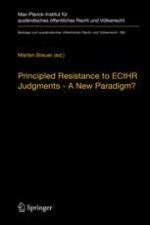
2019 | OriginalPaper | Buchkapitel
1. ‘Principled Resistance’ to ECtHR Judgments: Dogmatic Framework and Conceptual Meaning
verfasst von : Marten Breuer
Erschienen in: Principled Resistance to ECtHR Judgments - A New Paradigm?
Verlag: Springer Berlin Heidelberg
Aktivieren Sie unsere intelligente Suche, um passende Fachinhalte oder Patente zu finden.
Wählen Sie Textabschnitte aus um mit Künstlicher Intelligenz passenden Patente zu finden. powered by
Markieren Sie Textabschnitte, um KI-gestützt weitere passende Inhalte zu finden. powered by